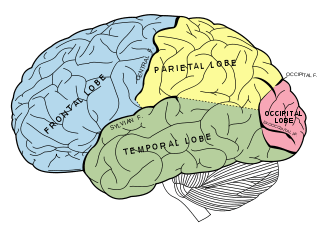Gerstmann syndrome
| Gerstmann syndrome | |
|---|---|
 | |
| Principal fissures and lobes of the cerebrum viewed laterally. (Parietal lobe is shown in yellow) | |
| Classification and external resources | |
| Specialty | psychiatry |
| ICD-10 | F81.2 |
| ICD-9-CM | 784.69 |
| DiseasesDB | 30728 |
| MeSH | D005862 |
Gerstmann syndrome is a neuropsychological disorder that is characterized by a constellation of symptoms that suggests the presence of a lesion in a particular area of the brain. (It should not be confused with Gerstmann-Sträussler-Scheinker syndrome, which is a transmissible spongiform encephalopathy.) Destruction to the inferior parietal lobule of the dominant hemisphere results in Gerstmann's syndrome.
It is named for Josef Gerstmann.[1]
Primary symptoms
Gerstmann syndrome is characterized by four primary symptoms:
- Dysgraphia/agraphia: deficiency in the ability to write[2][3]
- Dyscalculia/acalculia: difficulty in learning or comprehending mathematics[2][3]
- Finger agnosia: inability to distinguish the fingers on the hand[2][3]
- Left-right disorientation[2][3]
Causes
This disorder is often associated with brain lesions in the dominant (usually left) hemisphere including the angular and supramarginal gyri near the temporal and parietal lobe junction. There is significant debate in the scientific literature as to whether Gerstmann Syndrome truly represents a unified, theoretically motivated syndrome. Thus its diagnostic utility has been questioned by neurologists and neuropsychologists alike. The angular gyrus is generally involved in translating visual patterns of letter and words into meaningful information, such as is done while reading.
In adults
In adults, the syndrome may occur after a stroke or in association with damage to the parietal lobe.[3]
In addition to exhibiting the above symptoms, many adults also experience aphasia, which is a difficulty in expressing oneself when speaking, in understanding speech, or in reading and writing.
In children
There are few reports of the syndrome, sometimes called developmental Gerstmann syndrome, in children.[4] The cause is not known. Most cases are identified when children reach school age, a time when they are challenged with writing and math exercises. Generally, children with the disorder exhibit poor handwriting and spelling skills, and difficulty with math functions, including adding, subtracting, multiplying, and dividing. An inability to differentiate right from left and to discriminate among individual fingers may also be apparent. In addition to the four primary symptoms, many children also suffer from constructional apraxia, an inability to copy simple drawings. Frequently, there is also an impairment in reading. Children with a high level of intellectual functioning as well as those with brain damage may be affected with the disorder.
Treatment
There is no cure for Gerstmann syndrome. Treatment is symptomatic and supportive. Occupational and speech therapies may help diminish the dysgraphia and apraxia. In addition, calculators and word processors may help school children cope with the symptoms of the disorder.
Prognosis
In adults, many of the symptoms diminish over time. Although it has been suggested that a similar diminishing of symptoms occurs in children as well, it appears more likely that most do not overcome their deficits, but instead simply learn to adjust.[5]
References
- ↑ synd/2267 at Who Named It?
- 1 2 3 4 Vallar G (July 2007). "Spatial neglect, Balint-Homes' and Gerstmann's syndrome, and other spatial disorders". CNS Spectr. 12 (7): 527–36. PMID 17603404.
- 1 2 3 4 5 Carota A, Di Pietro M, Ptak R, Poglia D, Schnider A (2004). "Defective spatial imagery with pure Gerstmann's syndrome". Eur. Neurol. 52 (1): 1–6. doi:10.1159/000079251. PMID 15218337.
- ↑ Miller CJ, Hynd GW (April 2004). "What ever happened to developmental Gerstmann's syndrome? Links to other pediatric, genetic, and neurodevelopmental syndromes". J. Child Neurol. 19 (4): 282–9. doi:10.1177/088307380401900408. PMID 15163095.
- ↑ http://www.ninds.nih.gov/disorders/gerstmanns/gerstmanns.htm#What_is_the_prognosis
Further reading
- Ardila A, Rosselli M (December 2002). "Acalculia and dyscalculia" (PDF). Neuropsychol Rev. 12 (4): 179–231. doi:10.1023/a:1021343508573. PMID 12539968.
- "Gerstmann's Syndrome Information Page". National Institute of Neurological Disorders and Stroke (NINDS).
- Reeve R, Humberstone J (2011). "Five- to 7-year-olds' finger gnosia and calculation abilities". Front Psychol. 2: 359. doi:10.3389/fpsyg.2011.00359. PMC 3236444
 . PMID 22171220.
. PMID 22171220.